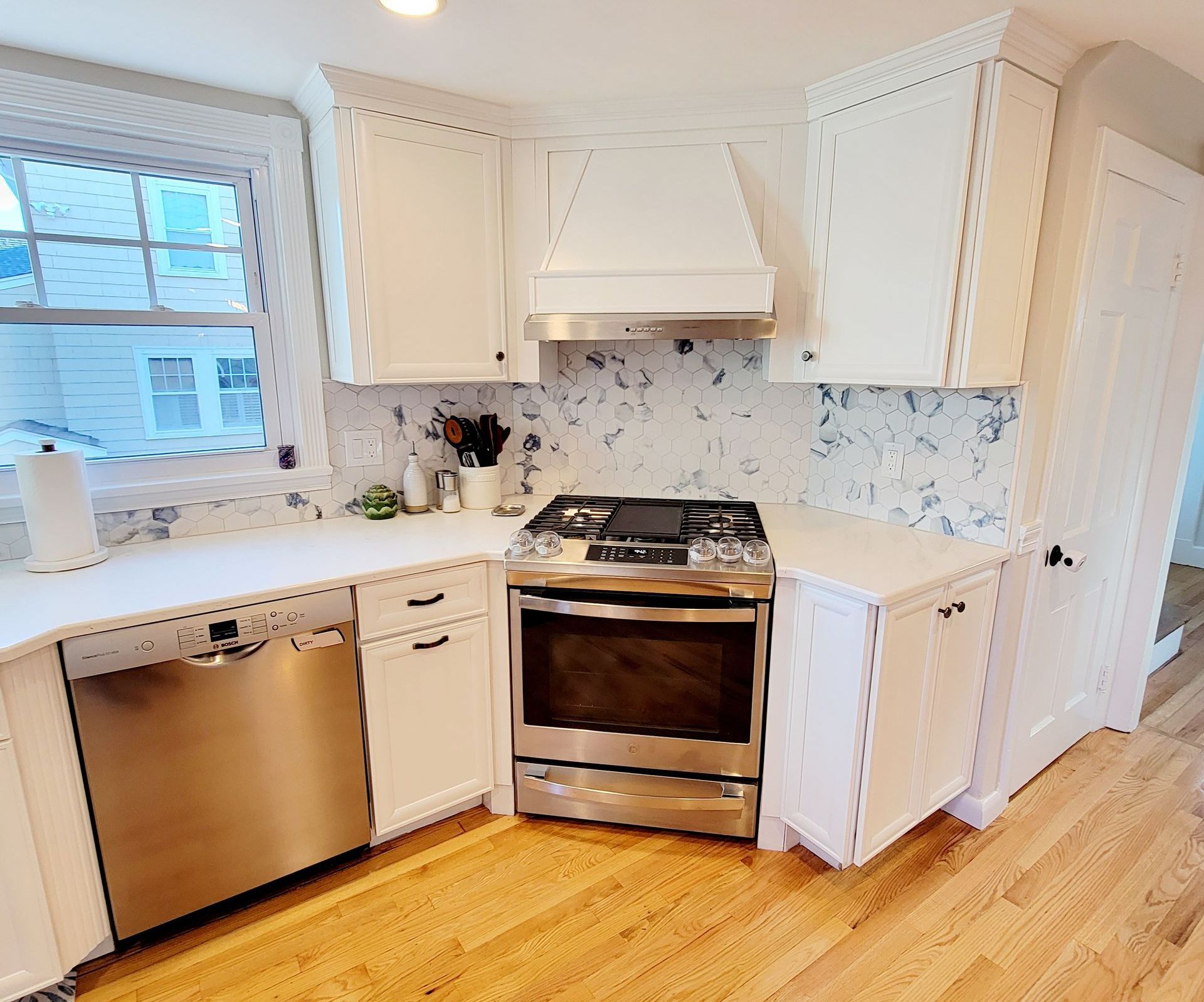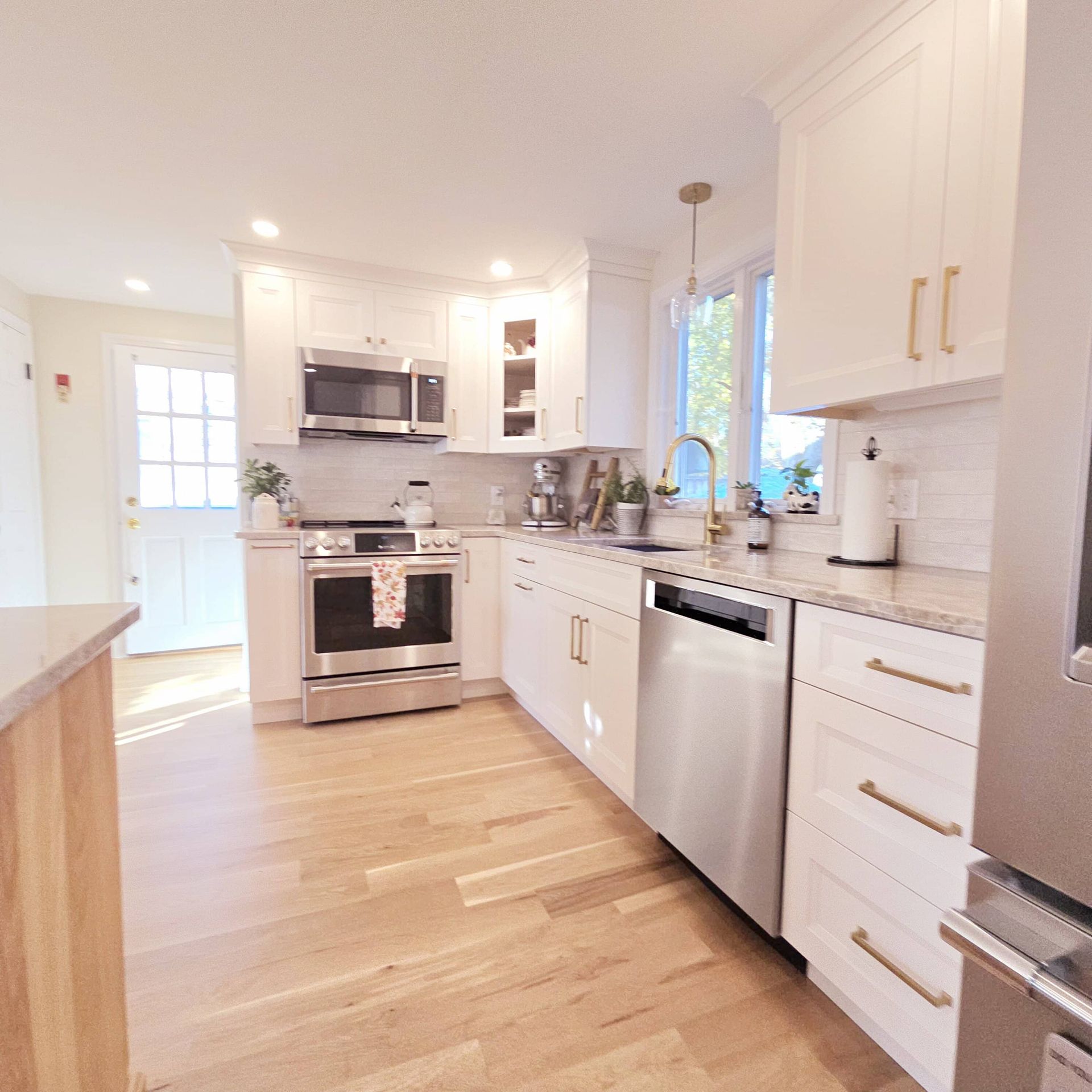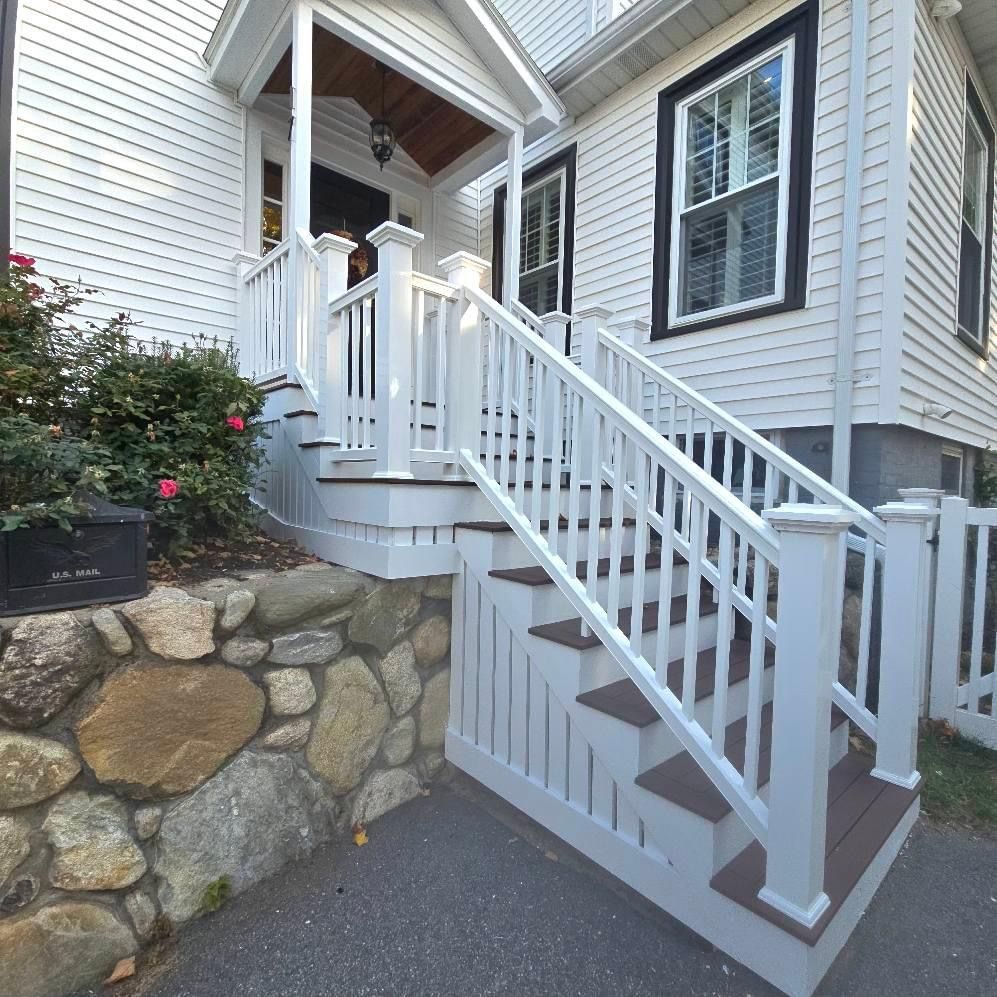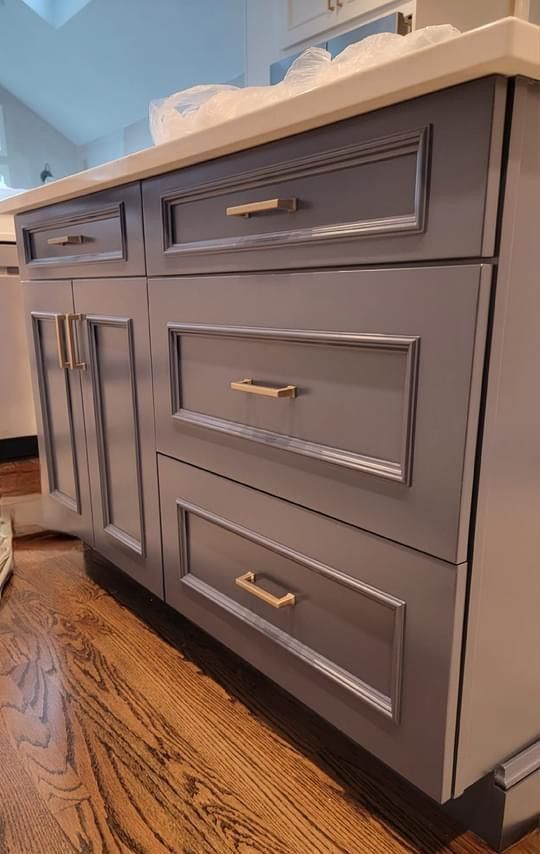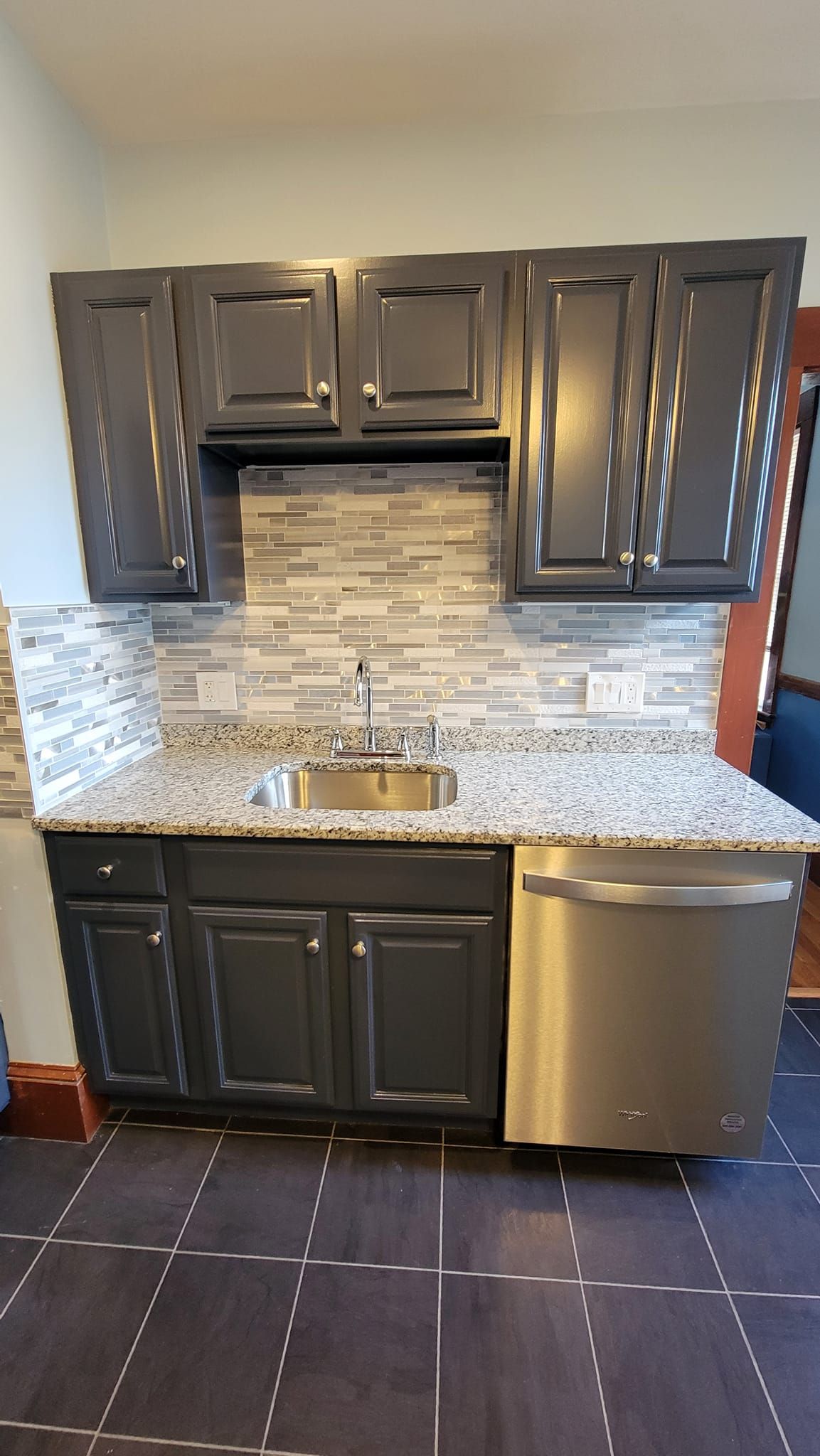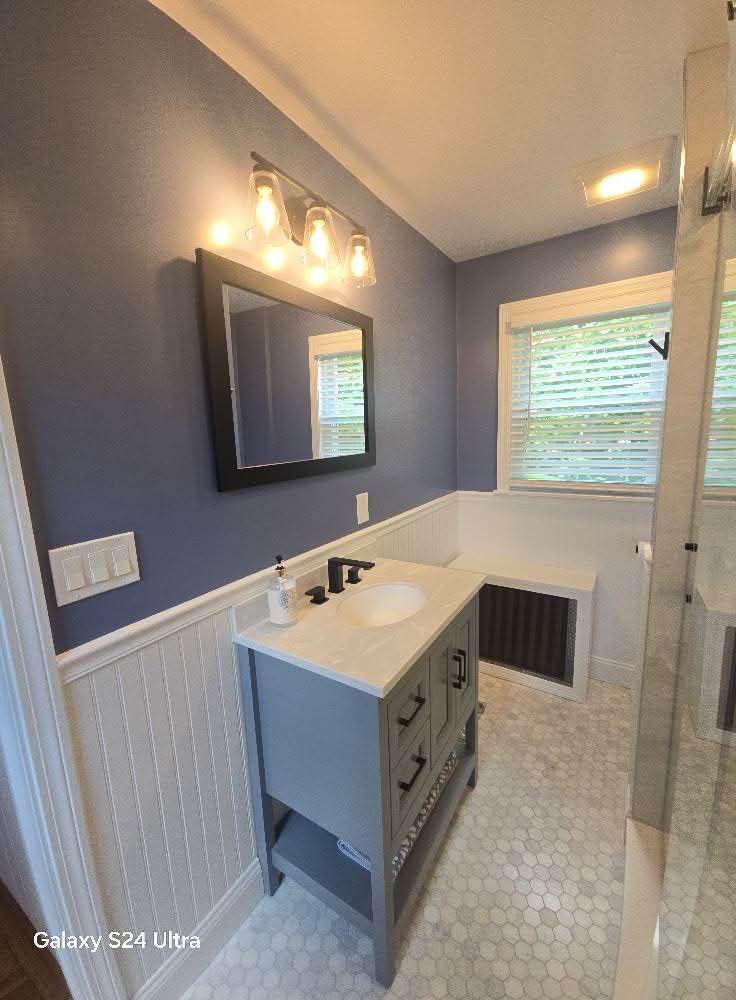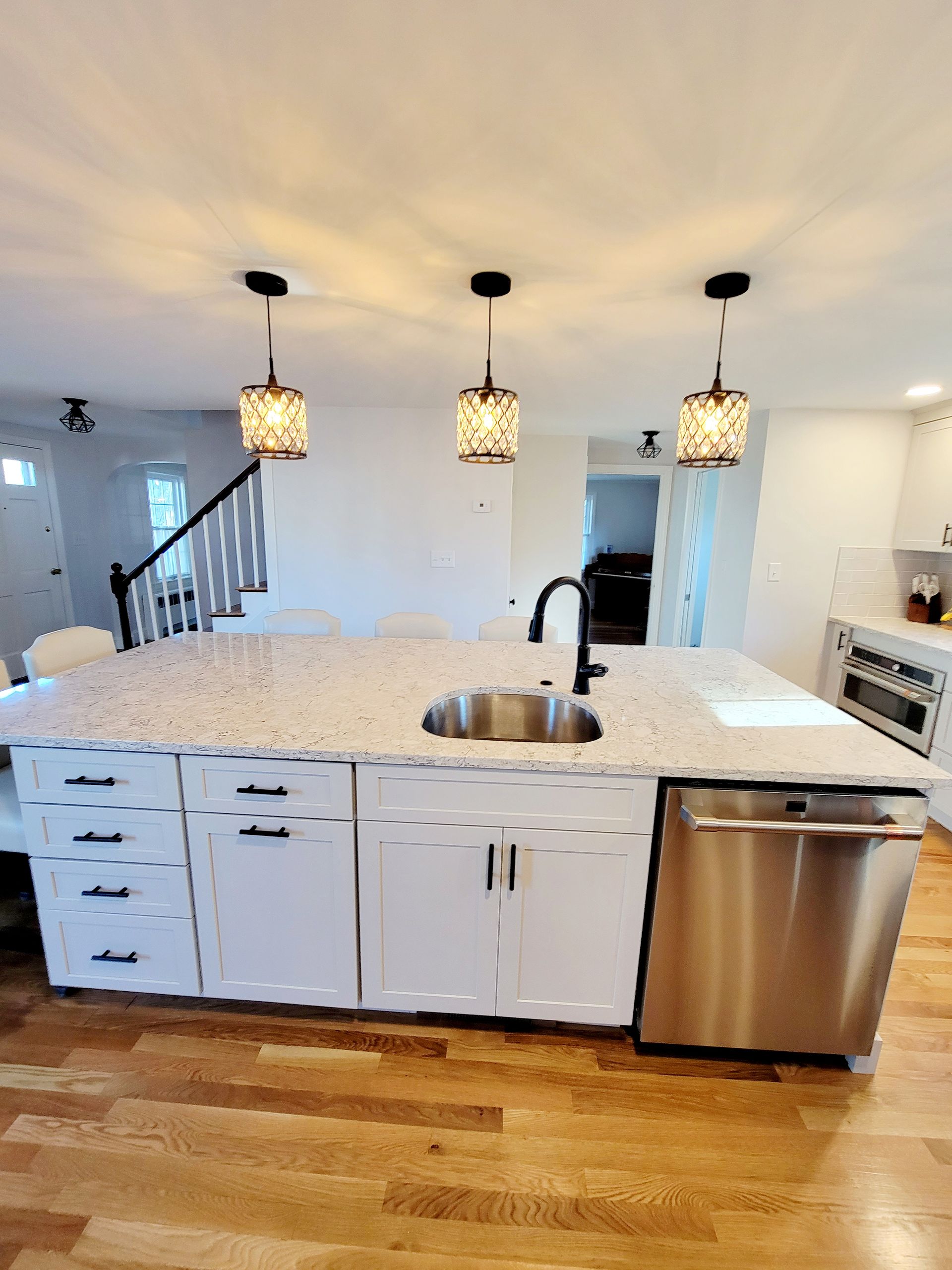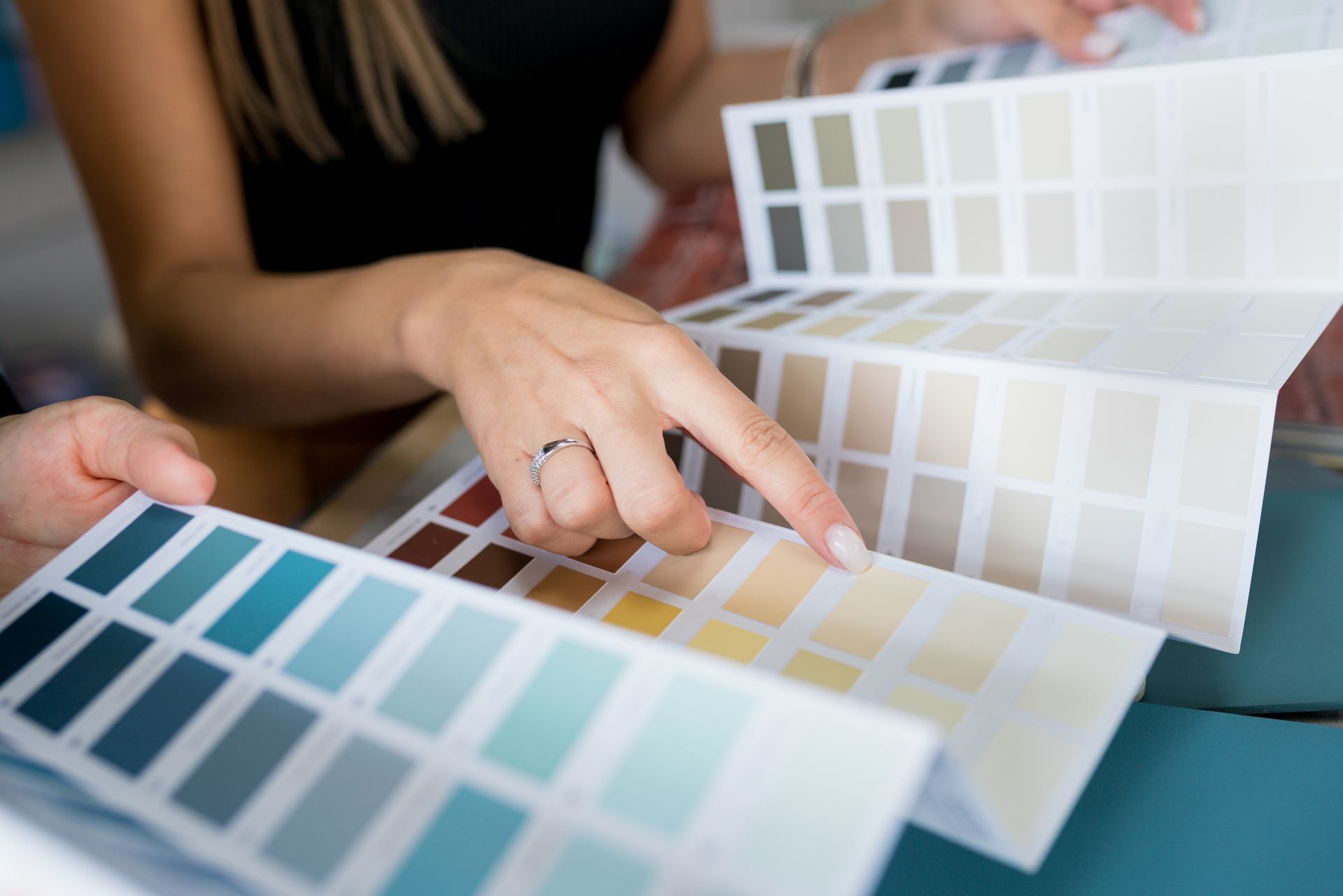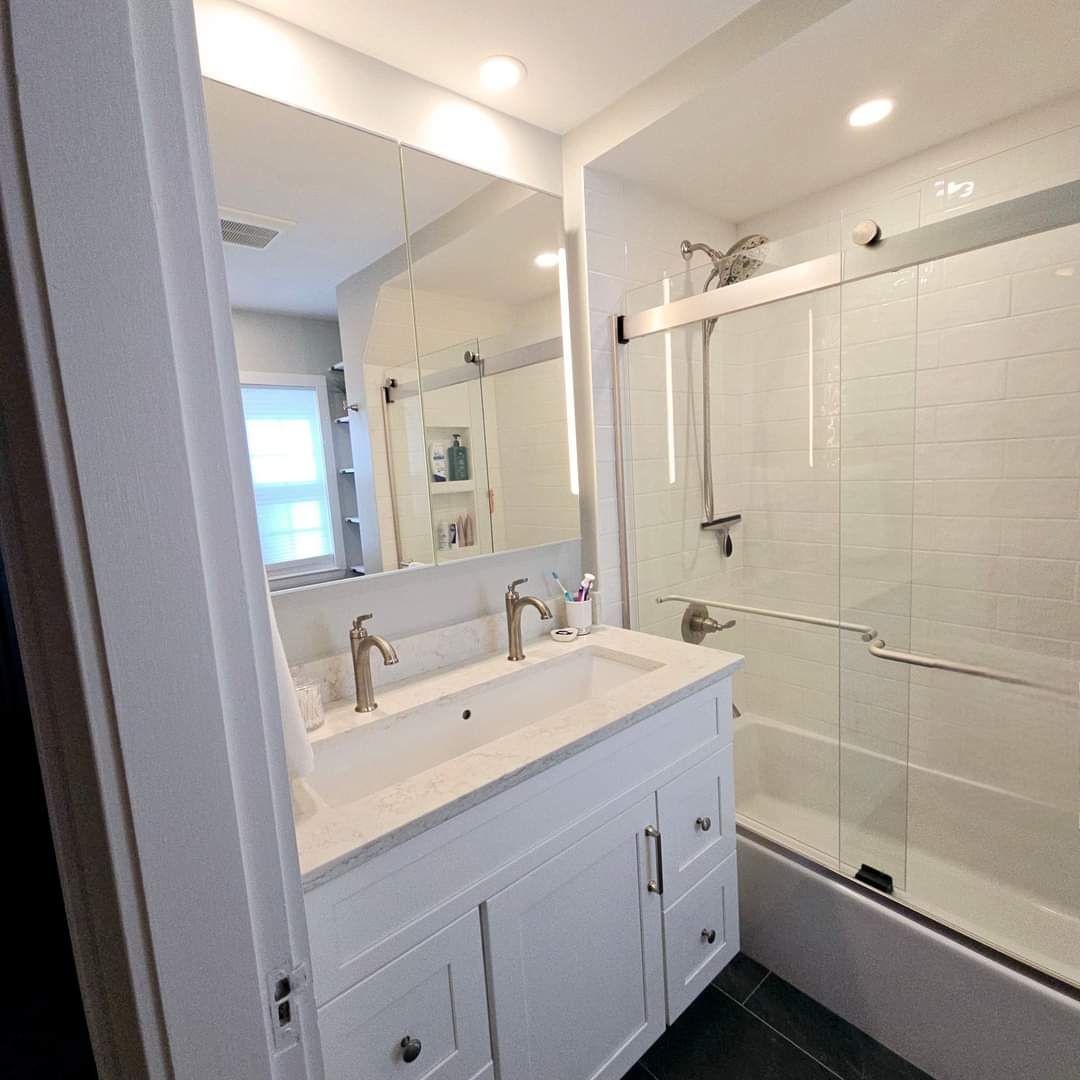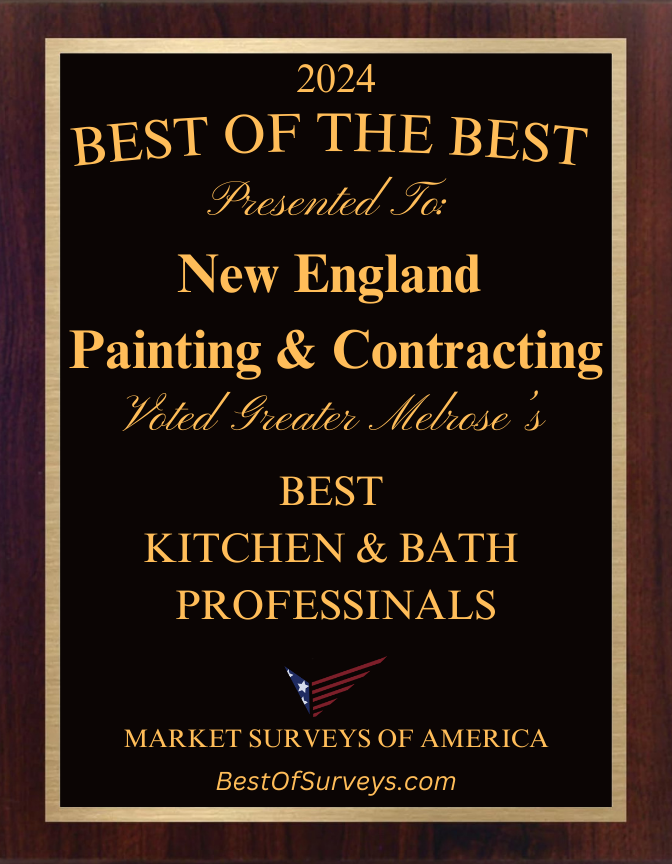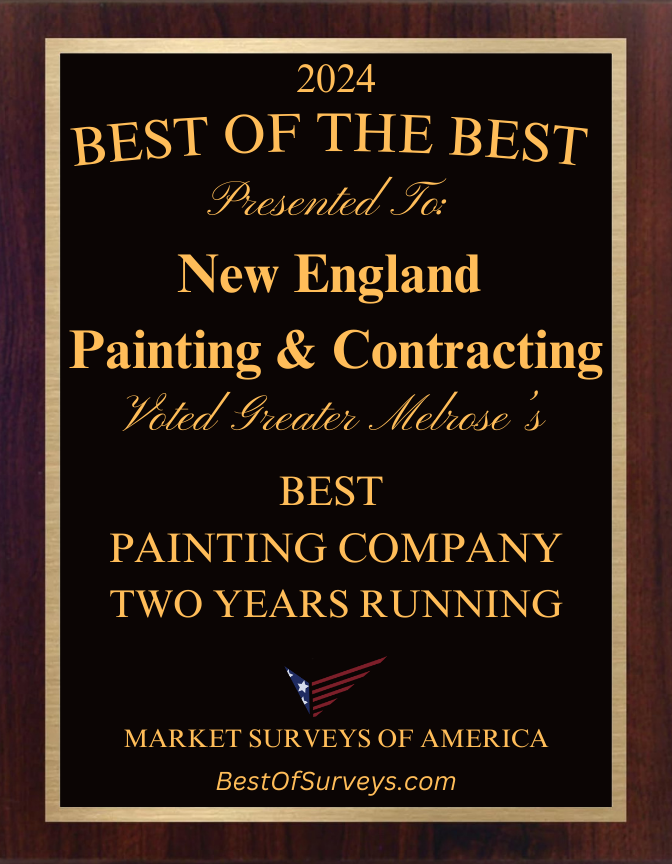Transform Your Kitchen: The Complete Guide to Cabinet Painting
Everything homeowners need to know about kitchen cabinet painting from understanding the process to evaluating professional options and making smart decisions for your space.
Your kitchen cabinets occupy nearly 40% of your kitchen's visual space, which means their appearance dramatically impacts your entire home. For homeowners in Melrose, Wakefield, and surrounding communities, outdated or worn cabinets often trigger thoughts of expensive remodeling projects. But there's a more affordable alternative that's gaining popularity throughout the region: professional cabinet painting.
Cabinet painting offers a cost-effective way to completely transform your kitchen's look without the disruption and expense of a full renovation. Whether you're dealing with oak cabinets from the 1990s or cherry wood that no longer matches your style, painting can breathe new life into your space while saving thousands of dollars.
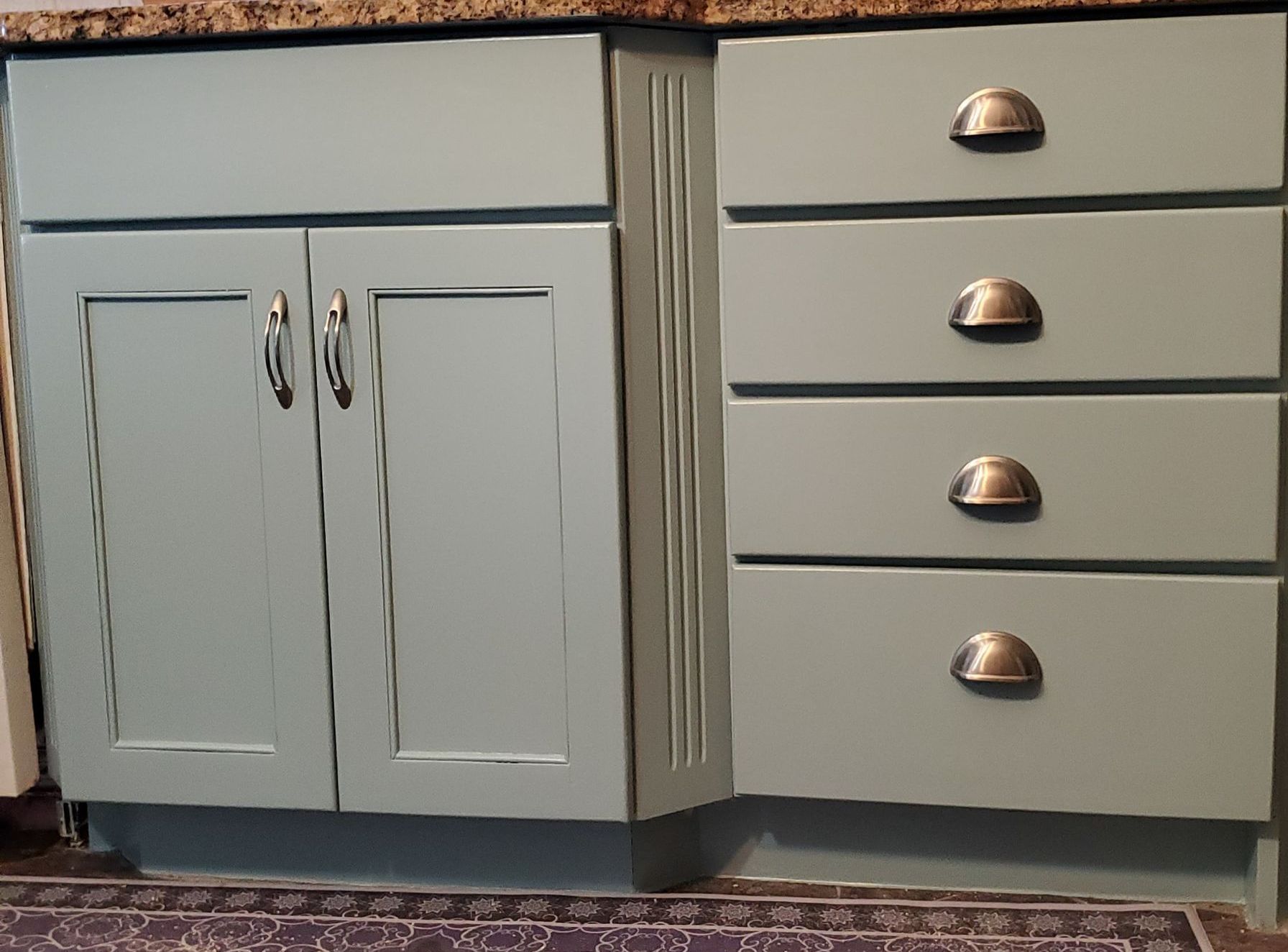
Why Paint Instead of Replace? Understanding Your Options
The difference between painting and replacing kitchen cabinets comes down to three main factors: cost, time, and environmental impact.
Replacing kitchen cabinets typically costs between $15,000 and $40,000 for an average-sized kitchen. This includes the cost of new cabinet boxes, doors, hardware, and installation labor. The process usually takes several weeks and requires completely emptying your kitchen. Many homeowners in Stoneham and Reading discover that cabinet replacement also uncovers unexpected issues like outdated electrical work or plumbing that needs updating, adding thousands more to the final bill.
Cabinet painting, in contrast, typically costs between $3,000 and $8,000 depending on kitchen size and cabinet condition. The process usually takes less than a week, and while your kitchen will be temporarily out of commission, the disruption is significantly shorter. For cabinets that are structurally sound but aesthetically outdated, painting delivers dramatic results at a fraction of replacement costs.
There's also an environmental consideration. Tearing out and disposing of perfectly functional cabinets sends substantial material to landfills. Painting keeps existing cabinets in service while giving you the updated look you want. For environmentally conscious homeowners throughout the Winchester area, this represents a genuinely sustainable choice.
The Cabinet Painting Process: What to Expect
Understanding the professional cabinet painting process helps you appreciate why proper preparation matters so much. Cutting corners during any step can lead to disappointing results that don't last.
The process begins with careful preparation. All cabinet doors and drawer fronts get removed, labeled, and transported to a workspace for proper preparation. Hardware is removed and either cleaned for reinstallation or replaced with new pieces. The cabinet boxes remaining in your kitchen are thoroughly cleaned to remove years of accumulated grease, cooking residue, and grime that can prevent paint from adhering properly.
Next comes detailed sanding and priming. Every surface gets sanded to create texture that helps paint bond effectively. This step is particularly important for cabinets with glossy factory finishes or wood grain that you want to minimize. A high-quality primer gets applied to all surfaces, creating the foundation for your finish coats. Many homeowners throughout Saugus are surprised to learn that proper priming can take an entire day for an average kitchen.
The painting itself involves multiple thin coats rather than one or two thick applications. Professional cabinet painters typically apply two to three coats of high-quality paint, allowing proper drying time between each coat. The cabinet boxes get painted in place, while doors and drawer fronts are spray-painted in a controlled environment for the smoothest possible finish.
Finally, everything gets reassembled once the paint has fully cured. Hardware is reinstalled, doors are rehung with careful attention to alignment, and drawer fronts are reattached. The entire process typically takes five to seven days from start to finish.
Current Color Trends for Kitchen Cabinets
Color choice dramatically impacts your kitchen's overall feel and the perceived value of your home. Current trends reflect a shift toward both bold statements and sophisticated neutrals.
White cabinets remain the most popular choice throughout Melrose and surrounding areas. Classic white creates a clean, bright feel that makes kitchens appear larger and more open. It works well with virtually any countertop color and allows flexibility with other design elements. However, true white has evolved to include warmer options like Swiss Coffee or Alabaster that prevent the stark, clinical feel of pure white.
Gray cabinets have surged in popularity over the past five years. Greige tones—colors that blend gray and beige—offer sophistication without feeling cold. These colors complement both traditional and contemporary kitchen designs and pair beautifully with the stainless-steel appliances common in most modern kitchens.
Navy blue and forest green represent the growing trend toward bold, dramatic cabinets. These deep colors create striking focal points and work particularly well in kitchens with plenty of natural light. Many Wakefield homeowners are choosing to paint lower cabinets in navy while keeping upper cabinets white, creating visual interest without overwhelming the space.
Two-tone kitchens continue to gain traction. Pairing a darker color on base cabinets with lighter uppers creates depth and dimension. This approach also grounds the room visually while maintaining an open, airy feel at eye level.
How Long Does Cabinet Paint Last?
One of the most common questions homeowners ask concerns durability. Will the paint chip? How long before cabinets need repainting?
When professionally applied using high-quality materials and proper techniques, painted kitchen cabinets can last 10 to 15 years before needing attention. This longevity depends on several factors, including the quality of preparation, the paint products used, and how you care for your cabinets.
Modern cabinet paints are specifically formulated to withstand the kitchen environment. They resist moisture, heat, grease, and the constant touching that kitchen cabinets endure. High-quality acrylic or alkyd enamels create hard, durable finishes that hold up remarkably well to daily use.
The key to longevity lies in proper preparation. Cabinets that are thoroughly cleaned, properly sanded, and primed before painting will hold paint far better than those that receive minimal prep work. This is why professional cabinet painting often delivers better long-term results than DIY attempts—the time invested in preparation makes all the difference.
Your maintenance habits also impact longevity. Wiping up spills promptly, avoiding harsh chemical cleaners, and using gentle cleaning methods help painted cabinets maintain their appearance for many years. Most homeowners in Reading find that their painted cabinets look as good after five years as they did on day one, provided they exercise reasonable care.
Preparation: The Foundation of Beautiful Results
The difference between a cabinet painting project that looks professional and one that disappoints often comes down to preparation. This phase accounts for roughly 60% of the total project time but determines the final result's quality.
Surface preparation begins with deep cleaning. Kitchen cabinets accumulate a film of cooking oils, grease, and airborne particles that create an invisible barrier between wood and paint. Professional cabinet painters use deglossers and specialized cleaners to remove this buildup completely. Skipping this step is the most common reason paint fails to adhere properly.
After cleaning comes sanding. This process serves multiple purposes: it removes the existing finish's sheen, smooths out imperfections, and creates texture that helps primer and paint bond effectively. Different areas require different grits of sandpaper—coarse grits for heavy sanding, finer grits for final smoothing. Cabinet doors typically need more extensive sanding than frames, particularly if you're painting over wood grain.
Any damage must be addressed before painting. Small dents, scratches, or gouges get filled with wood filler, allowed to dry completely, and then sanded smooth. Loose joints need to be re-glued. Hardware holes that won't be reused should be filled. Cabinet doors that don't close properly need adjustment. Addressing these issues before painting ensures your finished cabinets look and function properly.
Priming represents the final preparation step. A high-quality primer creates the foundation that allows finish coats to adhere and provides a uniform surface for even color coverage. Primer also blocks stains and prevents tannins in wood from bleeding through your finish coat. For cabinets with dark stain or wood that tends to bleed, specialized stain-blocking primers are essential.
Many homeowners in Winchester and Stoneham are surprised to learn that preparation takes three to four days for an average kitchen. However, this investment in time and effort directly determines your project's success.
Common Questions and Concerns About Cabinet Painting
Will the paint chip easily? Properly applied cabinet paint shouldn't chip under normal use. The key lies in surface preparation and using paint specifically formulated for cabinets. These specialized paints cure to a hard finish that resists chipping far better than standard wall paint. Most chipping issues trace back to inadequate preparation or using inappropriate paint products.
How long will my kitchen be out of commission? Expect your kitchen to be partially unavailable for about a week. You'll lose access to upper and lower cabinets during this time, though you can typically still use your appliances. Many homeowners set up a temporary kitchen area in their dining room with frequently used items. Planning meals that don't require much prep work makes the process much easier.
Can any cabinets be painted? Most cabinets can be successfully painted, but some are better candidates than others. Solid wood cabinets paint beautifully and last the longest. Laminate cabinets can be painted but require special primers and more careful surface preparation. Cabinets with damaged or peeling laminate may not be good candidates. Structurally sound cabinets with outdated finishes are ideal for painting. If cabinet boxes are falling apart, doors don't close properly, or drawers no longer function smoothly, replacement might be the better choice.
What about the mess? Professional cabinet painters take doors and drawer fronts off-site for spraying, which eliminates most mess in your home. The cabinet boxes get painted in place, but careful masking protects your countertops, floors, and walls. Expect some dust during the sanding phase, but reputable contractors use dust extraction equipment and protect your home with drop cloths and plastic sheeting.
Making Your Cabinet Painting Project Successful
Success with cabinet painting requires realistic expectations and good planning. Understanding that the process takes time helps you prepare mentally and logistically for temporary kitchen disruption.
Start by clearing out your cabinets completely. This is an excellent opportunity to declutter, discard expired items, and organize what you keep. Plan your temporary storage carefully—you'll need access to everyday items but can box up seasonal or rarely used pieces.
Consider this project an opportunity to upgrade hardware as well. New handles and pulls cost relatively little but significantly impact your kitchen's updated look. Modern hardware options suit any style, from contemporary to traditional, and installation is straightforward.
Think about your long-term plans for the space. If you're planning a full kitchen renovation within the next two years, painting cabinets might not make sense. However, if you're looking to refresh your kitchen for the next five to ten years, cabinet painting offers excellent value.
For homeowners throughout Melrose, Wakefield, Stoneham, Saugus, Reading, and Winchester, painted cabinets represent a smart investment that delivers immediate visual impact without the cost and disruption of full replacement. Your kitchen can look completely transformed while your cabinets remain structurally sound and fully functional for many years to come.
